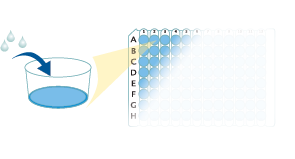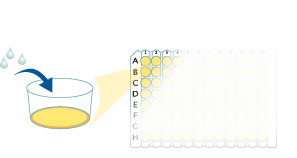Human TRAIL/TNFSF10 Quantikine ELISA Kit Summary
Product Summary
Precision
Cell Culture Supernates, Cell Lysates, Saliva
| Intra-Assay Precision | Inter-Assay Precision | |||||
|---|---|---|---|---|---|---|
| Sample | 1 | 2 | 3 | 1 | 2 | 3 |
| n | 20 | 20 | 20 | 40 | 40 | 40 |
| Mean (pg/mL) | 95 | 193 | 391 | 96 | 191 | 388 |
| Standard Deviation | 4.26 | 8.81 | 24.3 | 8.3 | 14.8 | 22.2 |
| CV% | 4.5 | 4.6 | 6.2 | 8.6 | 7.7 | 5.7 |
Serum, EDTA Plasma, Heparin Plasma
| Intra-Assay Precision | Inter-Assay Precision | |||||
|---|---|---|---|---|---|---|
| Sample | 1 | 2 | 3 | 1 | 2 | 3 |
| n | 20 | 20 | 20 | 40 | 40 | 40 |
| Mean (pg/mL) | 102 | 203 | 408 | 102 | 202 | 407 |
| Standard Deviation | 3.45 | 5.73 | 23 | 7.59 | 12.2 | 17.8 |
| CV% | 3.4 | 2.8 | 5.6 | 7.5 | 6.1 | 4.4 |
Recovery
The recovery of TRAIL spiked to levels throughout the range of the assay in various matrices was evaluated.
| Sample Type | Average % Recovery | Range % |
|---|---|---|
| Cell Culture Media (n=4) | 101 | 92-105 |
| EDTA Plasma (n=4) | 103 | 96-112 |
| Heparin Plasma (n=4) | 103 | 98-115 |
| Serum (n=4) | 96 | 91-102 |
Linearity
Scientific Data
Preparation and Storage
Background: TRAIL/TNFSF10
TNF-related apoptosis-inducing ligand (TRAIL), also known as Apo-2 ligand and TNFSF10, is a type II transmembrane protein with a carboxy-terminal extracellular domain that exhibits homology to other TNF superfamily members. Among TNF superfamily members, TRAIL is the most homologous to Fas Ligand, sharing 28% amino acid sequence identity in their extracellular domains. Human TRAIL shares 65% amino acid sequence identity with mouse TRAIL and is active on mouse cells.
Assay Procedure
Refer to the product- Prepare all reagents, standard dilutions, and samples as directed in the product insert.
- Remove excess microplate strips from the plate frame, return them to the foil pouch containing the desiccant pack, and reseal.
- Add 100 µL of Assay Diluent to each well.
- Add 50 µL of Standard, control, or sample to each well. Cover with a plate sealer, and incubate at room temperature for 2 hours on a horizontal orbital microplate shaker.
- Aspirate each well and wash, repeating the process 3 times for a total of 4 washes.
- Add 200 µL of Conjugate to each well. Cover with a new plate sealer, and incubate at room temperature for 2 hours on the shaker.
- Aspirate and wash 4 times.
- Add 200 µL Substrate Solution to each well. Incubate at room temperature for 30 minutes on the benchtop. PROTECT FROM LIGHT.
- Add 50 µL of Stop Solution to each well. Read at 450 nm within 30 minutes. Set wavelength correction to 540 nm or 570 nm.





Citations for Human TRAIL/TNFSF10 Quantikine ELISA Kit
R&D Systems personnel manually curate a database that contains references using R&D Systems products. The data collected includes not only links to publications in PubMed, but also provides information about sample types, species, and experimental conditions.
36
Citations: Showing 1 - 10
Filter your results:
Filter by:
-
CRISPR screens identify novel regulators of cFLIP dependency and ligand-independent, TRAIL-R1-mediated cell death
Authors: N Kuehnle, SM Osborne, Z Liang, M Manzano, E Gottwein
Cell Death and Differentiation, 2023-02-18;0(0):.
Species: Human
Sample Types: Cell Culture Supernates
-
Systemic and mucosal immune profiling in asymptomatic and symptomatic SARS-CoV-2-infected individuals reveal unlinked immune signatures
Authors: S Ravichandr, G Grubbs, J Tang, Y Lee, C Huang, H Golding, S Khurana
Science Advances, 2021-10-13;7(42):eabi6533.
Species: Human
Sample Types: Nasal Lavage Fluid
-
Hypoxia-Induced Epithelial-to-Mesenchymal Transition in Proximal Tubular Epithelial Cells through miR-545-3p-TNFSF10
Authors: MC Kuo, WA Chang, LY Wu, YC Tsai, YL Hsu
Biomolecules, 2021-07-15;11(7):.
Species: Human
Sample Types: Cell Culture Supernates
-
Engineering of Doxorubicin-Encapsulating and TRAIL-Conjugated Poly(RGD) Proteinoid Nanocapsules for Drug Delivery Applications
Authors: E Hadad, S Rudnick-Gl, E Itzhaki, MY Avivi, I Grinberg, Y Elias, S Margel
Polymers, 2020-12-16;12(12):.
Species: Human
Sample Types: Cell Culture Supernates
-
Identification of pathogenic TRAIL-expressing innate immune cells during HIV-1 infection in humanized mice by scRNA-Seq
Authors: L Cheng, H Yu, JA Wrobel, G Li, P Liu, Z Hu, XN Xu, L Su
JCI Insight, 2020-06-04;5(11):.
Species: Humanized Mouse
Sample Types: Plasma
-
M1 Macrophages Promote TRAIL Expression in Adipose Tissue-Derived Stem Cells, Which Suppresses Colitis-Associated Colon Cancer by Increasing Apoptosis of CD133+ Cancer Stem Cells and Decreasing M2 Macrophage Population
Authors: YW Eom, R Akter, W Li, S Lee, S Hwang, J Kim, MY Cho
Int J Mol Sci, 2020-05-29;21(11):.
Species: Human
Sample Types: Cell Culture Supernates
-
Efficient recruitment of c-FLIPL to the death-inducing signaling complex leads to Fas resistance in natural killer-cell lymphoma
Authors: A Masuda, Y Isobe, K Sugimoto, M Yoshimori, A Arai, N Komatsu
Cancer Sci., 2020-01-31;111(3):807-816.
Species: Human
Sample Types: Cell Culture Supernates
-
Circulating cell death biomarker TRAIL is associated with increased organ dysfunction in sepsis
Authors: EJ Schenck, KC Ma, DR Price, T Nicholson, C Oromendia, ER Gentzler, E Sanchez, RM Baron, LE Fredenburg, JW Huh, II Siempos, AM Choi
JCI Insight, 2019-05-02;4(9):.
Species: Human
Sample Types: Plasma
-
Soluble TRAIL Armed Human MSC As Gene Therapy For Pancreatic Cancer
Authors: C Spano, G Grisendi, G Golinelli, F Rossignoli, M Prapa, M Bestagno, O Candini, T Petrachi, A Recchia, F Miselli, G Rovesti, G Orsi, A Maiorana, P Manni, E Veronesi, MS Piccinno, A Murgia, M Pinelli, EM Horwitz, S Cascinu, P Conte, M Dominici
Sci Rep, 2019-02-11;9(1):1788.
Species: Human
Sample Types: Cell Culture Supernates
-
MSC-Delivered Soluble TRAIL and Paclitaxel as Novel Combinatory Treatment for Pancreatic Adenocarcinoma
Authors: F Rossignoli, C Spano, G Grisendi, EM Foppiani, G Golinelli, I Mastrolia, M Bestagno, O Candini, T Petrachi, A Recchia, F Miselli, G Rovesti, G Orsi, E Veronesi, G Medici, B Petocchi, M Pinelli, EM Horwitz, P Conte, M Dominici
Theranostics, 2019-01-01;9(2):436-448.
Species: Human
Sample Types: Cell Culture Supernates
-
Relationship between low levels of circulating TRAIL and atheromatosis progression in patients with chronic kidney disease
Authors: MV Arcidiacon, E Rimondi, E Maietti, E Melloni, V Tisato, S Gallo, JM Valdiviels, E Fernández, À Betriu, R Voltan, G Zauli, S Volpato, P Secchiero
PLoS ONE, 2018-09-11;13(9):e0203716.
Species: Human
Sample Types: Serum
-
TRAIL and Ceruloplasmin Inverse Correlation as a Representative Crosstalk between Inflammation and Oxidative Stress
Authors: V Tisato, S Gallo, E Melloni, C Celeghini, A Passaro, G Zauli, P Secchiero, C Bergamini, A Trentini, G Bonaccorsi, G Valacchi, G Zuliani, C Cervellati
Mediators Inflamm., 2018-07-26;2018(0):9629537.
Species: Human
Sample Types: Serum
-
TRAIL mediates and sustains constitutive NF-κB activation in LGL leukemia
Authors: J Yang, FR LeBlanc, SA Dighe, CE Hamele, TL Olson, DJ Feith, TP Loughran
Blood, 2018-04-26;0(0):.
Species: Human
Sample Types: Serum
-
Lower maternal serum tumor necrosis factor-related apoptosis-inducing ligand (TRAIL) levels in early preeclampsia. A retrospective study
Authors: D Morano, A Rolfo, V Tisato, A Farina, E Rimondi, G Scutiero, P Greco, G Bonaccorsi, T Todros
Pregnancy Hypertens, 2018-02-07;12(0):1-5.
Species: Human
Sample Types: Serum
-
Anti-tumor effects of ONC201 in combination with VEGF-inhibitors significantly impacts colorectal cancer growth and survival in vivo through complementary non-overlapping mechanisms
Authors: J Wagner, CL Kline, L Zhou, V Khazak, WS El-Deiry
J. Exp. Clin. Cancer Res., 2018-01-22;37(1):11.
Species: Mouse
Sample Types: Serum
-
Engineering T Cells with Customized Therapeutic Response Programs Using Synthetic Notch Receptors.
Authors: Roybal K, Williams J, Morsut L, Rupp L, Kolinko I, Choe J, Walker W, McNally K, Lim W
Cell, 2016-09-29;167(2):419-432.e16.
Species: Human
Sample Types: Cell Culture Supernates
-
Expression of osteoprotegerin and its ligands, RANKL and TRAIL, in rheumatoid arthritis
Sci Rep, 2016-07-12;6(0):29713.
Species: Human
Sample Types: Serum
-
Clonal evolution in patients with chronic lymphocytic leukaemia developing resistance to BTK inhibition
Nat Commun, 2016-05-20;7(0):11589.
Species: Human
Sample Types: Plasma
-
TRAIL-receptor preferences in pancreatic cancer cells revisited: Both TRAIL-R1 and TRAIL-R2 have a licence to kill.
Authors: Mohr A, Yu R, Zwacka R
BMC Cancer, 2015-07-03;15(0):494.
Species: Human
Sample Types: Cell Culture Supernates
-
TRAIL Is Decreased Before 20 Weeks Gestation in Women with Hypertensive Disorders of Pregnancy.
Authors: Zhou C, Long Y, Yang H, Zhu C, Ma Q, Zhang Y
PLoS ONE, 2015-06-01;10(6):e0128425.
Species: Human
Sample Types: Plasma
-
Clinically applicable human adipose tissue-derived mesenchymal stem cells delivering therapeutic genes to brainstem gliomas.
Authors: Choi S, Lee Y, Kwak P, Lee J, Kim S, Lee S, Phi J, Wang K, Song J, Song S, Joo K, Kim S
Cancer Gene Ther, 2015-05-29;22(6):302-11.
Species: Human
Sample Types: Cell Culture Supernates
-
Silencing Daxx increases the anti-tumor activity of a TRAIL/shRNA Bcl-xL-expressing oncolytic adenovirus through enhanced viral replication and cellular arrest.
Authors: Kang S, Kang D, Bakhtiar Ul Islam S, Je S, Kim J, Song J
Cell Signal, 2015-03-05;27(6):1214-24.
Species: Human
Sample Types: Cell Culture Supernates
-
Systemic anticancer neural stem cells in combination with a cardiac glycoside for glioblastoma therapy.
Authors: Teng J, Hejazi S, Badr C, Tannous B
Stem Cells, 2014-08-01;32(8):2021-32.
Species: Human, Mouse
Sample Types: Cell Culture Supernates, Whole Tissue
-
A novel TLR-9 agonist C792 inhibits plasmacytoid dendritic cell-induced myeloma cell growth and enhance cytotoxicity of bortezomib.
Authors: Ray A, Tian Z, Das D, Coffman R, Richardson P, Chauhan D, Anderson K
Leukemia, 2014-01-30;28(8):1716-24.
Species: Human
Sample Types: Cell Culture Supernates
-
Attenuated, oncolytic, but not wild-type measles virus infection has pleiotropic effects on human neutrophil function.
Authors: Zhang Y, Patel B, Dey A, Ghorani E, Rai L, Elham M, Castleton AZ, Fielding AK
J. Immunol., 2011-12-16;188(3):1002-10.
Species: Human
Sample Types: Cell Culture Supernates
-
Potential role of soluble TRAIL in epithelial injury in children with severe RSV infection.
Authors: Bem RA, Bos AP, Wosten-van Asperen RM, Bruijn M, Lutter R, Sprick MR, van Woensel JB
Am. J. Respir. Cell Mol. Biol., 2009-07-27;42(6):697-705.
Species: Human
Sample Types: BALF
-
Prognostic value of apoptosis markers in advanced heart failure patients.
Authors: Niessner A, Hohensinner PJ, Rychli K, Neuhold S, Zorn G, Richter B, Hulsmann M, Berger R, Mortl D, Huber K, Wojta J, Pacher R
Eur. Heart J., 2009-02-04;30(7):789-96.
Species: Human
Sample Types: Plasma
-
Conjunctival sac fluid contains elevated levels of soluble TRAIL: implications for the anti-tumoral surveillance of the anterior surface of the eye.
Authors: Secchiero P, Lamberti G, Corallini F, Melloni E, Guarnotta C, Sebastiani A, Zauli G
J. Cell. Physiol., 2009-01-01;218(1):199-204.
Species: Human
Sample Types: Conjunctival Fluid
-
Tumor necrosis factor-related apoptosis-inducing ligand promotes migration of human bone marrow multipotent stromal cells.
Authors: Secchiero P, Melloni E, Corallini F, Beltrami AP, Alviano F, Milani D, D'Aurizio F, di Iasio MG, Cesselli D, Bagnara GP, Zauli G
Stem Cells, 2008-09-04;26(11):2955-63.
Species: Human
Sample Types: Cell Culture Supernates
-
Osteoprotegerin decreases human osteoclast apoptosis by inhibiting the TRAIL pathway.
Authors: Chamoux E, Houde N, L'Eriger K, Roux S
J. Cell. Physiol., 2008-08-01;216(2):536-42.
Species: Human
Sample Types: Cell Culture Supernates
-
TRAIL limits excessive host immune responses in bacterial meningitis.
Authors: Hoffmann O, Priller J, Prozorovski T, Schulze-Topphoff U, Baeva N, Lunemann JD, Aktas O, Mahrhofer C, Stricker S, Zipp F, Weber JR
J. Clin. Invest., 2007-07-01;117(7):2004-13.
Species: Human
Sample Types: CSF
-
Insulin down-regulates TRAIL expression in vascular smooth muscle cells both in vivo and in vitro.
Authors: Corallini F, Celeghini C, Rizzardi C, Pandolfi A, Di Silvestre S, Vaccarezza M, Zauli G
J. Cell. Physiol., 2007-07-01;212(1):89-95.
Species: Human
Sample Types: Serum
-
Gene modulatory effects, pharmacokinetics, and clinical tolerance of interferon-alpha1b: a second member of the interferon-alpha family.
Authors: Masci P, Olencki T, Wood L, Rybicki L, Jacobs B, Williams B, Faber P, Bukowski R, Tong K, Borden EC
Clin. Pharmacol. Ther., 2007-03-01;81(3):354-61.
Species: Human
Sample Types: Serum
-
Erythropoiesis abnormalities contribute to early-onset anemia in patients with septic shock.
Authors: Claessens YE, Fontenay M, Pene F, Chiche JD, Guesnu M, Hababou C, Casadevall N, Dhainaut JF, Mira JP, Cariou A
Am. J. Respir. Crit. Care Med., 2006-03-30;174(1):51-7.
Species: Human
Sample Types: Plasma
-
HIV-1 tat protein and cell proliferation and survival: a brief review.
Authors: Gibellini D, Vitone F, Schiavone P, Re MC
New Microbiol., 2005-04-01;28(2):95-109.
Species: Human
Sample Types: Plasma
-
Evidence for a role of TNF-related apoptosis-inducing ligand (TRAIL) in the anemia of myelodysplastic syndromes.
Authors: Campioni D, Secchiero P, Corallini F, Melloni E, Capitani S, Lanza F, Zauli G
Am. J. Pathol., 2005-02-01;166(2):557-63.
Species: Human
Sample Types: Cell Culture Supernates
FAQs
No product specific FAQs exist for this product, however you may
View all ELISA FAQsReviews for Human TRAIL/TNFSF10 Quantikine ELISA Kit
Average Rating: 5 (Based on 1 Review)
Have you used Human TRAIL/TNFSF10 Quantikine ELISA Kit?
Submit a review and receive an Amazon gift card.
$25/€18/£15/$25CAN/¥75 Yuan/¥2500 Yen for a review with an image
$10/€7/£6/$10 CAD/¥70 Yuan/¥1110 Yen for a review without an image
Filter by:








